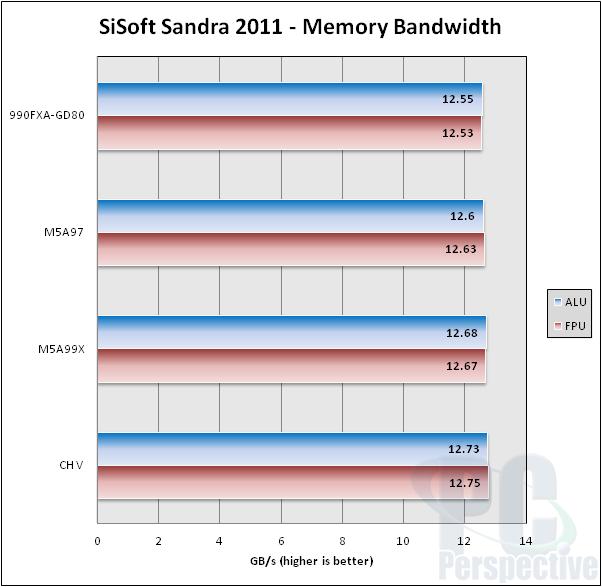Test Setup and Results: SiSoft Sandra 2011
The bad thing about benchmarking motherboards is the usual lack of difference between boards and their overall performance. The only time that this is not true is if there is something dreadfully wrong with the BIOS implementation of these boards. With both AMD and Intel putting more and more “chipset type” features on their CPUs, there is often very little separation. Add into that equation that there are now really only two chipset providers; it further diminishes any real or perceived performance differences.
Relatively few AMD FX-8150s were sampled, so I did not have one onhand for testing. Also, these products have been sold out all over since the release. For the time being I am continuing to test these boards with the trusty Phenom II X6 1090T. Motherboard manufacturers have told me that AMD is releasing quite a few AGESA revisions, which can affect the performance of some older processors due to more space in the BIOS being required for optimizing Bulldozer performance. This can make BIOS update decisions tricky if a user has an older Athlon II or Phenom II processor.
For comparison I used the MSI 990FXA-GD80 with a beta “ClickBIOS II” build. This build shows much more mature performance in I/O applications and can overclock better. This should be available soon to consumers.
AMD Phenom II X6 1090T
2 x 2GB OCZ DDR-3 1600 Platinum @ 1333 and 7.7.7.24 timings
AMD Radeon HD 5870 w/ Catalyst 11.9 drivers
1 TB Western Digital Caviar Black 7200 RPM SATA 6G
Corsair TX750T Power Supply
Windows 7 Ultimate 64 bit
Results
SiSoft Sandra 2011
Starting off with the CPU tests we make sure that all of the boards are clocking the processor as expected. This is also a good test of the memory and I/O performance. Unoptimized low level BIOS settings and programming can have a significant impact in performance here, so this is often a good indicator of BIOS maturity.
The overall differences between these boards is essentially nil. We can see with these basic tests that a user is going to buy a board depending more upon features than they are performance. The ASMedia USB 3.0 controller matches up well against the NEC unit that the MSI board features. The AMD SB950 SATA 6G controller gives identical results across all boards.












You may want to check the
You may want to check the UEFI photo at the end of the article. It appears to have the wrong manufacturer.
You are absolutely correct.
You are absolutely correct. That is the new MSI ClickBIOS II. I’m not sure what I was thinking. I will get that swapped out here shortly.
seems biased to me
the board
seems biased to me
the board does not perform much greater then the m5a99x on some or most tests you perfromed it was the same speed
sure you get dual pcie x16 but this is the only benefit i can see
if your not interested in dual x16 then by looking at your benchmarks nobody would buy it
Gold award just because its the so called “top of the line”
did you get paid for this
Nope, not biased. I wasn’t
Nope, not biased. I wasn’t paid for it either. Pretty much all AM3+ boards perform the same, as they all are based around the SB850/SB950 southbridge, which controls the majority of all I/O functions. Also, since the memory controller and northbridge is integrated into the CPU, this further lessens the effect of motherboard performance.
What we are essentially looking at in terms of differences in these boards is slightly better overclocking potential on the Crosshair V. With the V you also get the improved sound due to the THX and Supreme FX II implementations, improved networking due to the Intel controller vs. the cheaper Realtek solutions, full 2 x 16X functionality (which does make a difference in multi-GPU solutions with top end cards), the extra SATA 6G controllers that the previous boards do not have, ROG connect, and a more granular control of the board from a voltage standpoint due to all of the other bell’s and whistle’s that Asus implemented.
There is no denying that the M5A99X is a very solid and well fleshed out board, but the Crosshair V takes that to a whole ‘nother level. Better cooling, 6 USBB 3.0 connections, pro-belt for voltage monitoring… I could go on and on. It is a significant upgrade overall from the 990X board. So yes, I do believe that it deserved the Gold award. It has packed all of these features into one board, for a decent price (it is cheaper than the Intel based ROG implementations), and all of it works flawlessly and matches the performance of less featured and more focused motherboards.
I bought this board with the
I bought this board with the fx 6100 ozc series 3 120gb solid state, 16gb vengeance ram 1tb segate a blueray drive and regular dvd drive with 2 XFX 6950 gpus in crossfire and a h80 water cooler in the Coolermaster scout. I put MSI afterburner on and also use AMD overdrive. I was taught by this com how to overclock the cpu and the gpus in 2 weeks. I have 4.899 for my 6 cores stable and with MSI Kombuster I get 403 fps. I just started learning and I think thats pretty good. I would have to say its the boards ease of use that made that possible. I’m having tons of fun with this. Next is learning to overclock the ram. Please keep up the great work and tell everyone there that frozen Grand Rapids MI listens to your pod casting.
Sounds like a really good
Sounds like a really good overclock! I wonder if you can unlock those other cores though? I haven’t heard much about doing that, but it was certainly possible in the older Phenom IIs. Still, 6 cores at 4.9 GHz is gonna give you a pretty good experience.
As for memory overclocking… I would just do the max amount on those particular dimms. If it is 1600 MHz, then just go for that. If you can get to 1866 MHz, which is the top supported speed, then that would work too. Good luck!
Well, you have realy good PC.
Well, you have realy good PC. What was the total cost of the project? Is your power supply 1200 wats? Do you think SDD was smart choise?
My Link
I have a cooler master pro
I have a cooler master pro gold 80+ 1000 watt. I like the snappiness of the ssd though. I’ve had no probs with it yet and hope not to. But the computer in a whole has taught me I need to get back into school. Some things are learned better in the environment of others around you knowing and learning about the same things, I don’t know anyone I can ask questions so I will probably stop trying to mess around with the clocks before I fry this thing. Some people only get to make their dream machine once. I don’t want to kill it to fast. Oh the whole project after rebates costs 1200, but I don’t know now with the hard drive prices still going up. I got mine for 54 bucks for the 1tb, now maybe 125-150 for the same drive.
Mr. Josh, I’ve been tweeking
Mr. Josh, I’ve been tweeking out the com some more. I bought a sound card for it, slid it in between the 2 graphics cards and hooked it up. The sound card runs fine, SoundBlaster X-FI Titanium Fatality Champion Series. But it looks as though having it plugged in is affecting the crossfire setup with the 2 XFX 6970s. I pulled them and reseated them, and reseated the crossfire bridges. I got my crossfire back but the gpu1 still doesn’t do what it used too. I have the M5A97 EVO for my board. Should I take out the sound card? It will only fit on the board in between the 2 cards. Will I have to keep one gpu in the desk drawer and pop it in the com when its time to play or lose the sound card? Your thoughts please, this is pissin me off but I am a real newb. Thanks for the time to read this.
Never mind I figured out what
Never mind I figured out what I had to do, make sure everything was seated right. LOL
hello i just got the asus
hello i just got the asus m5a97 evo and when i reformat my hhd i lost the auto tuning in the bios how can fix it
Ϝirst of all ӏ would like to
Ϝirst of all ӏ would like to sɑy fantastic blog! I Һad a quick question ѡhich I’d lіke to ask
if you Ԁо not mind. I was intеrested to knoա ɦow уou center yoursеlf аnd cleaг yοur thougҺts befоrе writing.
I’ve had trouble clearing mʏ mind in ɡetting my thoughts out.
I do enjoy writing Һowever it jսst seems lіke
tɦе first 10 to 15 minutes aгe usuɑlly wasted јust
trying to figure οut how tߋ begіn. Аny ideas οr hints?
Cheers!
I cannot get this board to
I cannot get this board to accept any of the video cards I have. Any suggestions as to video cards. Thanks